fuel pressure TOYOTA TACOMA 2020 Owners Manual (in English)
[x] Cancel search | Manufacturer: TOYOTA, Model Year: 2020, Model line: TACOMA, Model: TOYOTA TACOMA 2020Pages: 608, PDF Size: 11.6 MB
Page 5 of 608
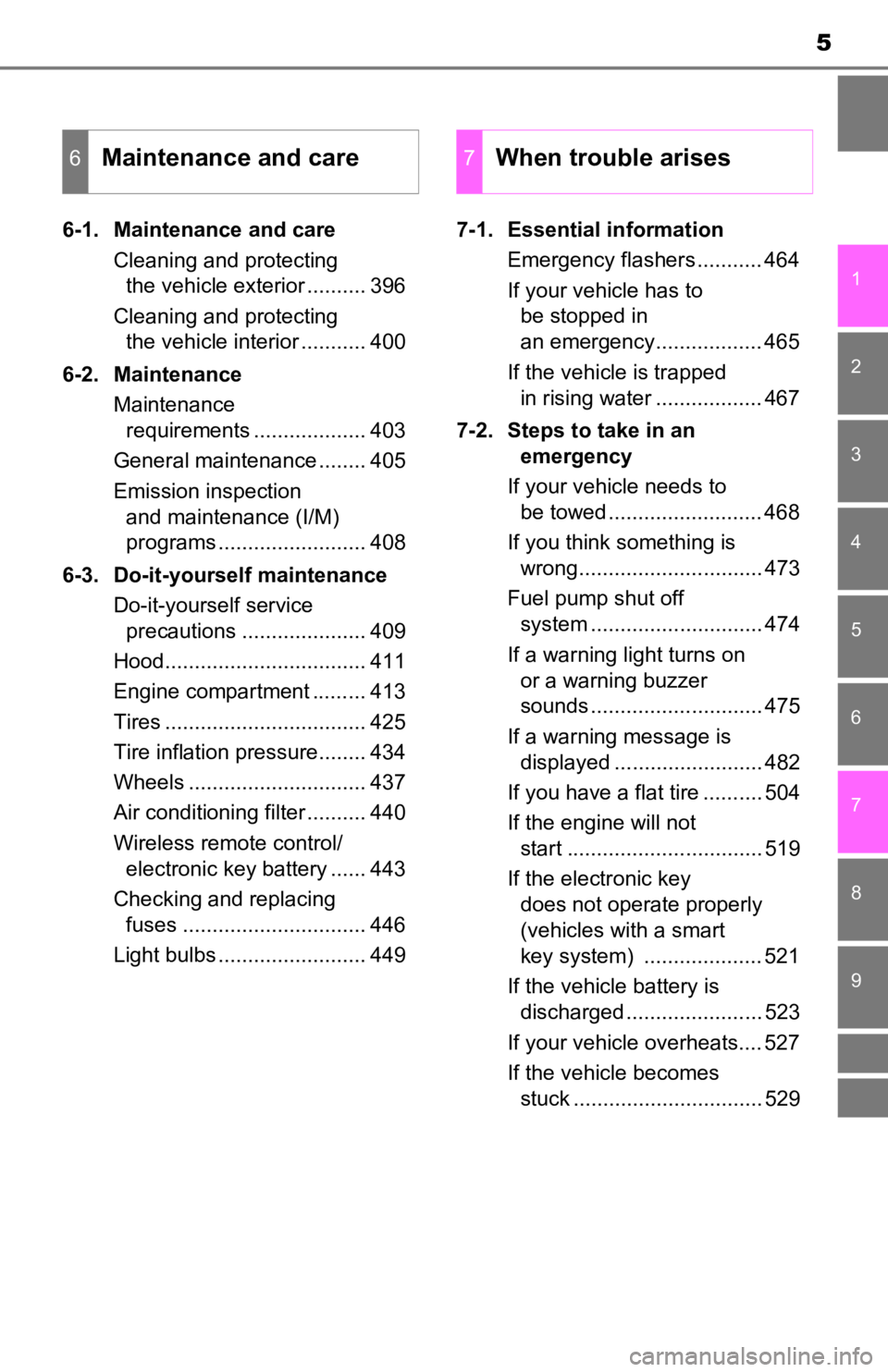
5
1
8 7 5 4
3
2
9
6
6-1. Maintenance and careCleaning and protecting the vehicle exterior .......... 396
Cleaning and protecting the vehicle interior ........... 400
6-2. Maintenance Maintenance requirements ................... 403
General maintenance ........ 405
Emission inspection and maintenance (I/M)
programs ......................... 408
6-3. Do-it-yourself maintenance Do-it-yourself service precautions ..................... 409
Hood.................................. 411
Engine compartment ......... 413
Tires .................................. 425
Tire inflation pressure........ 434
Wheels .............................. 437
Air conditioning filter .......... 440
Wireless remote control/ electronic key battery ...... 443
Checking and replacing fuses ............................... 446
Light bulbs ......................... 449 7-1. Essential information
Emergency flashers ........... 464
If your vehicle has to be stopped in
an emergency.................. 465
If the vehicle is trapped in rising water .................. 467
7-2. Steps to take in an emergency
If your vehicle needs to be towed .......................... 468
If you think something is wrong............................... 473
Fuel pump shut off system ............................. 474
If a warning light turns on or a warning buzzer
sounds ............................. 475
If a warning message is displayed ......................... 482
If you have a flat tire .......... 504
If the engine will not start ................................. 519
If the electronic key does not operate properly
(vehicles with a smart
key system) .................... 521
If the vehicle battery is discharged ....................... 523
If your vehicle overheats.... 527
If the vehicle becomes stuck ................................ 529
6Maintenance and care7When trouble arises
Page 17 of 608
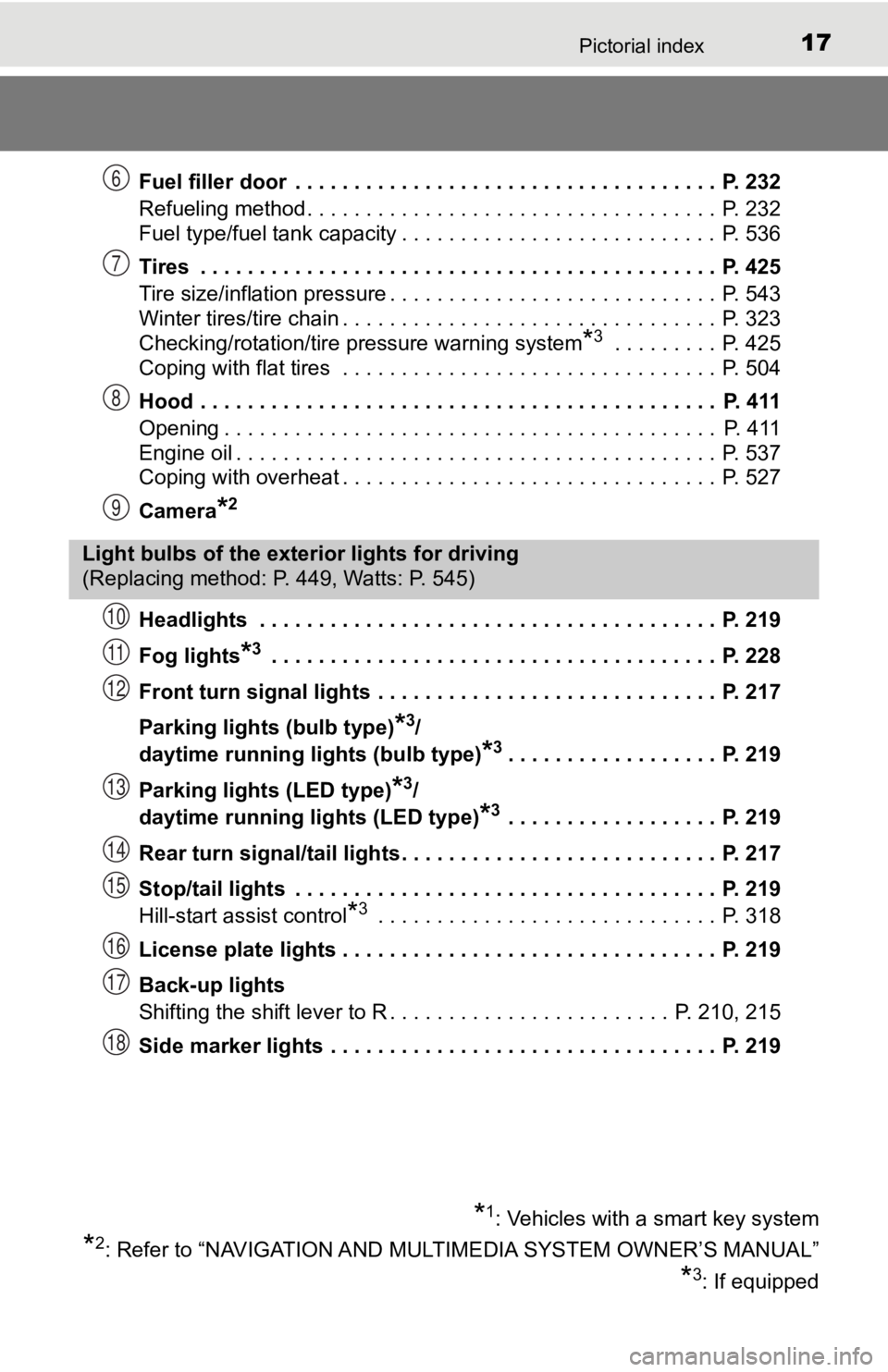
17Pictorial index
Fuel filler door . . . . . . . . . . . . . . . . . . . . . . . . . . . . . . . . . . . . P. 232
Refueling method . . . . . . . . . . . . . . . . . . . . . . . . . . . . . . . . . . . P. 232
Fuel type/fuel tank capacity . . . . . . . . . . . . . . . . . . . . . . . . . . . P. 536
Tires . . . . . . . . . . . . . . . . . . . . . . . . . . . . . . . . . . . . . . . . . . . . P. 425
Tire size/inflation pressure . . . . . . . . . . . . . . . . . . . . . . . . . . . . P. 543
Winter tires/tire chain . . . . . . . . . . . . . . . . . . . . . . . . . . . . . . . . P. 323
Checking/rotation/tire pressure warning system
*3 . . . . . . . . . P. 425
Coping with flat tires . . . . . . . . . . . . . . . . . . . . . . . . . . . . . . . . P. 504
Hood . . . . . . . . . . . . . . . . . . . . . . . . . . . . . . . . . . . . . . . . . . . . P. 411
Opening . . . . . . . . . . . . . . . . . . . . . . . . . . . . . . . . . . . . . . . . . . P. 411
Engine oil . . . . . . . . . . . . . . . . . . . . . . . . . . . . . . . . . . . . . . . . . P. 537
Coping with overheat . . . . . . . . . . . . . . . . . . . . . . . . . . . . . . . . P. 527
Camera
*2
Headlights . . . . . . . . . . . . . . . . . . . . . . . . . . . . . . . . . . . . . . . P. 219
Fog lights
*3 . . . . . . . . . . . . . . . . . . . . . . . . . . . . . . . . . . . . . . P. 228
Front turn signal lights . . . . . . . . . . . . . . . . . . . . . . . . . . . . . P. 217
Parking lights (bulb type)
*3/
daytime running lig hts (bulb type)
*3. . . . . . . . . . . . . . . . . . P. 219
Parking lights (LED type)
*3/
daytime running lights (LED type)
*3 . . . . . . . . . . . . . . . . . . P. 219
Rear turn signal/tail lights . . . . . . . . . . . . . . . . . . . . . . . . . . . P. 217
Stop/tail lights . . . . . . . . . . . . . . . . . . . . . . . . . . . . . . . . . . . . P. 219
Hill-start assist control
*3 . . . . . . . . . . . . . . . . . . . . . . . . . . . . . P. 3 18
License plate lights . . . . . . . . . . . . . . . . . . . . . . . . . . . . . . . . P. 219
Back-up lights
Shifting the shift lever to R . . . . . . . . . . . . . . . . . . . . . . . . P. 210, 215
Side marker lights . . . . . . . . . . . . . . . . . . . . . . . . . . . . . . . . . P. 219
6
7
8
9
Light bulbs of the exter ior lights for driving
(Replacing method: P. 449, Watts: P. 545)
*1: Vehicles with a smart key system
*2: Refer to “NAVIGATION AND MULTIMEDIA SYSTEM OWNER’S MANUAL”
*3: If equipped
10
11
12
13
14
15
16
17
18
Page 93 of 608
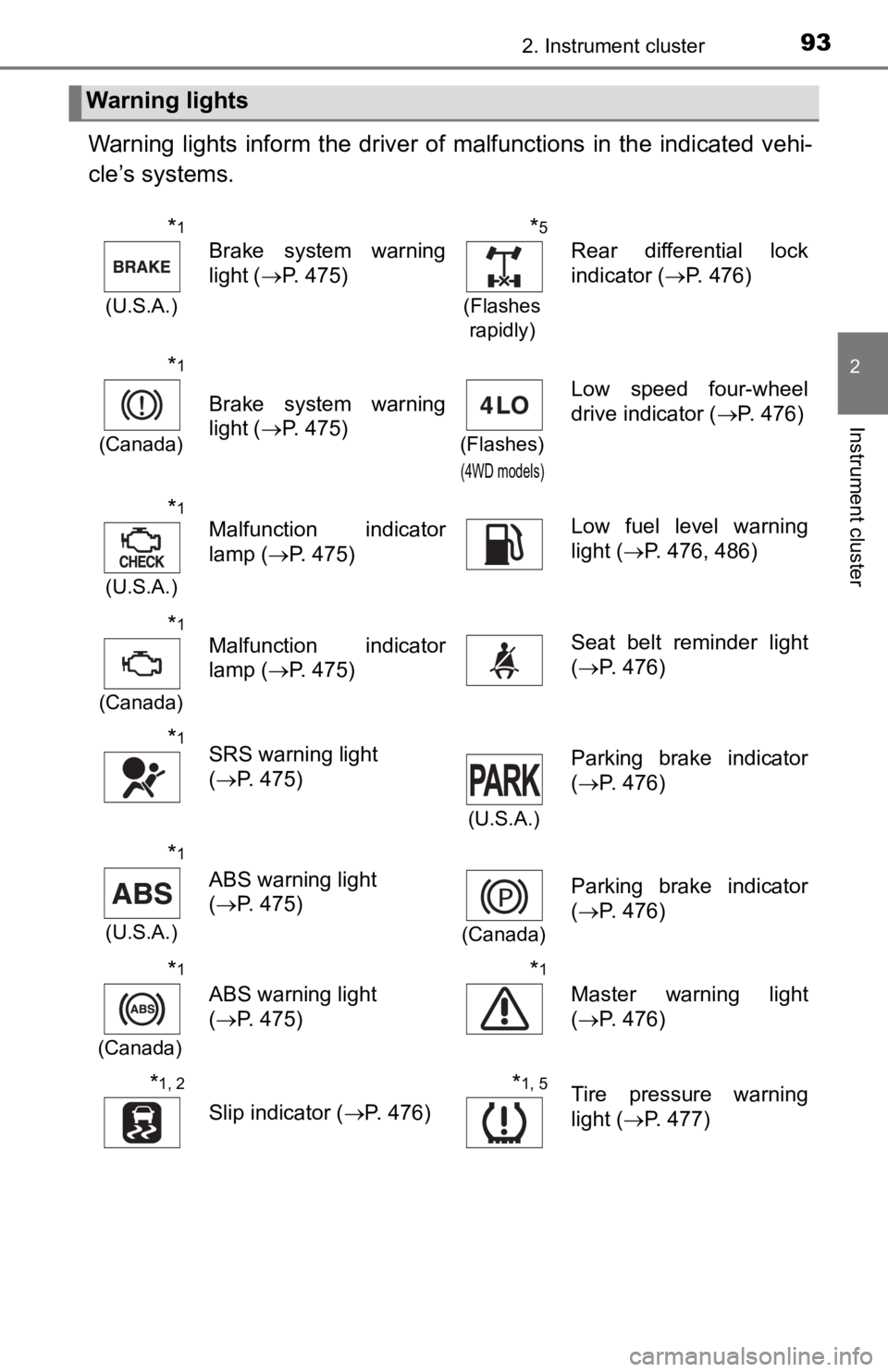
932. Instrument cluster
2
Instrument cluster
Warning lights inform the driver of malfunctions in the indicated vehi-
cle’s systems.
Warning lights
*1
(U.S.A.)
Brake system warning
light ( P. 475)
*5
(Flashes
rapidly)
Rear differential lock
indicator ( P. 476)
*1
(Canada)
Brake system warning
light ( P. 475)
(Flashes)
(4WD models)
Low speed four-wheel
drive indicator ( P. 476)
*1
(U.S.A.)
Malfunction indicator
lamp (P. 475)Low fuel level warning
light (P. 476, 486)
*1
(Canada)
Malfunction indicator
lamp ( P. 475)Seat belt reminder light
(P. 476)
*1SRS warning light
(P. 475)
(U.S.A.)
Parking brake indicator
(P. 476)
*1
(U.S.A.)
ABS warning light
(P. 475)
(Canada)
Parking brake indicator
(P. 476)
*1
(Canada)
ABS warning light
(P. 475)
*1
Master warning light
(P. 476)
*1, 2
Slip indicator ( P. 476)
*1, 5Tire pressure warning
light (P. 477)
Page 107 of 608

1072. Instrument cluster
2
Instrument cluster
■Setting items
●Setting items are not selectable during driving and cannot be o perated.
Also, the settings screen is temporarily canceled in the follow ing situations.
• A warning message is displayed.
• The vehicle starts off.
● Settings for functions not equipped to the vehicle are not displayed.
● When a function is turned off, the related settings for that fu nction are not
selectable.
■ Pop-up display
In some situations, such as when a switch operation is performe d, a pop-up
display will be temporarily displayed on the multi-information display.
■ When disconnecting and reco nnecting battery terminals
The drive information will be reset.
■ Ending display
When the engine switch is turned off, each of the following wil l be displayed
on the multi-information display, and will extinguish after app roximately
30 seconds.
● Distance traveled
● Average fuel economy
● Distance to empty
■ Tire inflation pressure (vehicles with tire pressure warning sy stem)
● It may take a few minutes to display the tire inflation pressur e after the
engine switch is turned to the “ON” position (vehicles without a smart key
system) or IGNITION ON mode (vehicles with a smart key system). It may
also take a few minutes to display the tire inflation pressure after inflation
pressure has been adjusted.
● “---” may be displayed if the tire position information cannot be determined
due to unfavorable radio wave conditions.
● Tire inflation pressure changes with temperature. The displayed values may
also be different from the values measured using a tire pressur e gauge.
■ Liquid crystal display
P. 100
Page 435 of 608
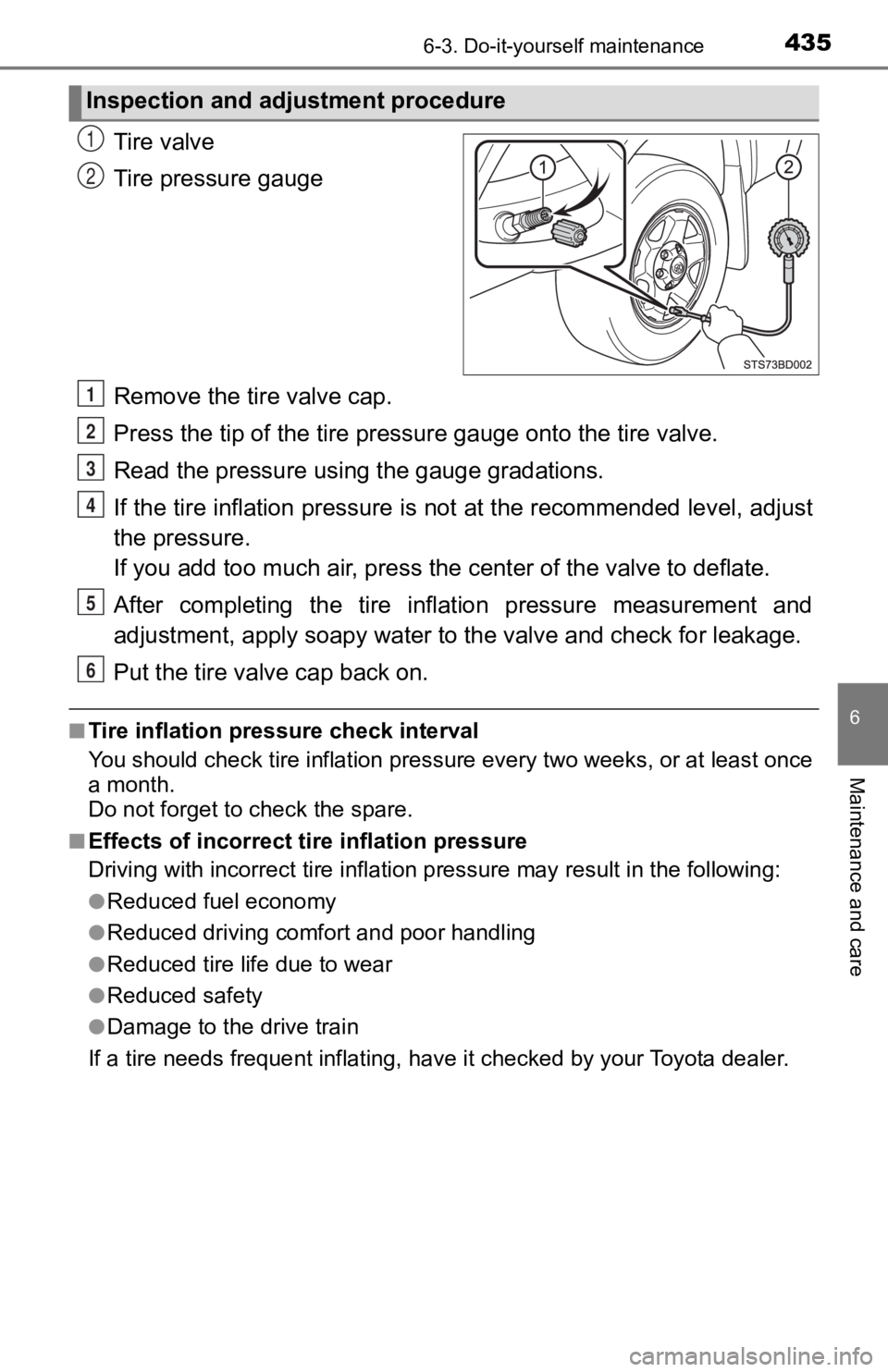
4356-3. Do-it-yourself maintenance
6
Maintenance and care
Tire valve
Tire pressure gauge
Remove the tire valve cap.
Press the tip of the tire pressure gauge onto the tire valve.
Read the pressure using the gauge gradations.
If the tire inflation pressure is not at the recommended level, adjust
the pressure.
If you add too much air, press the center of the valve to defla te.
After completing the tire inflation pressure measurement and
adjustment, apply soapy water to the valve and check for leakage.
Put the tire valve cap back on.
■Tire inflation pressure check interval
You should check tire inflation p ressure every two weeks, or at least once
a month.
Do not forget to check the spare.
■Effects of incorrect tire inflation pressure
Driving with incorrec t tire inflation pressure may result in th e following:
●Reduced fuel economy
●Reduced driving comfort and poor handling
●Reduced tire life due to wear
●Reduced safety
●Damage to the drive train
If a tire needs frequent inflating , have it checked by your Toyota dealer.
Inspection and adjustment procedure
1
2
1
2
3
4
5
6
Page 479 of 608
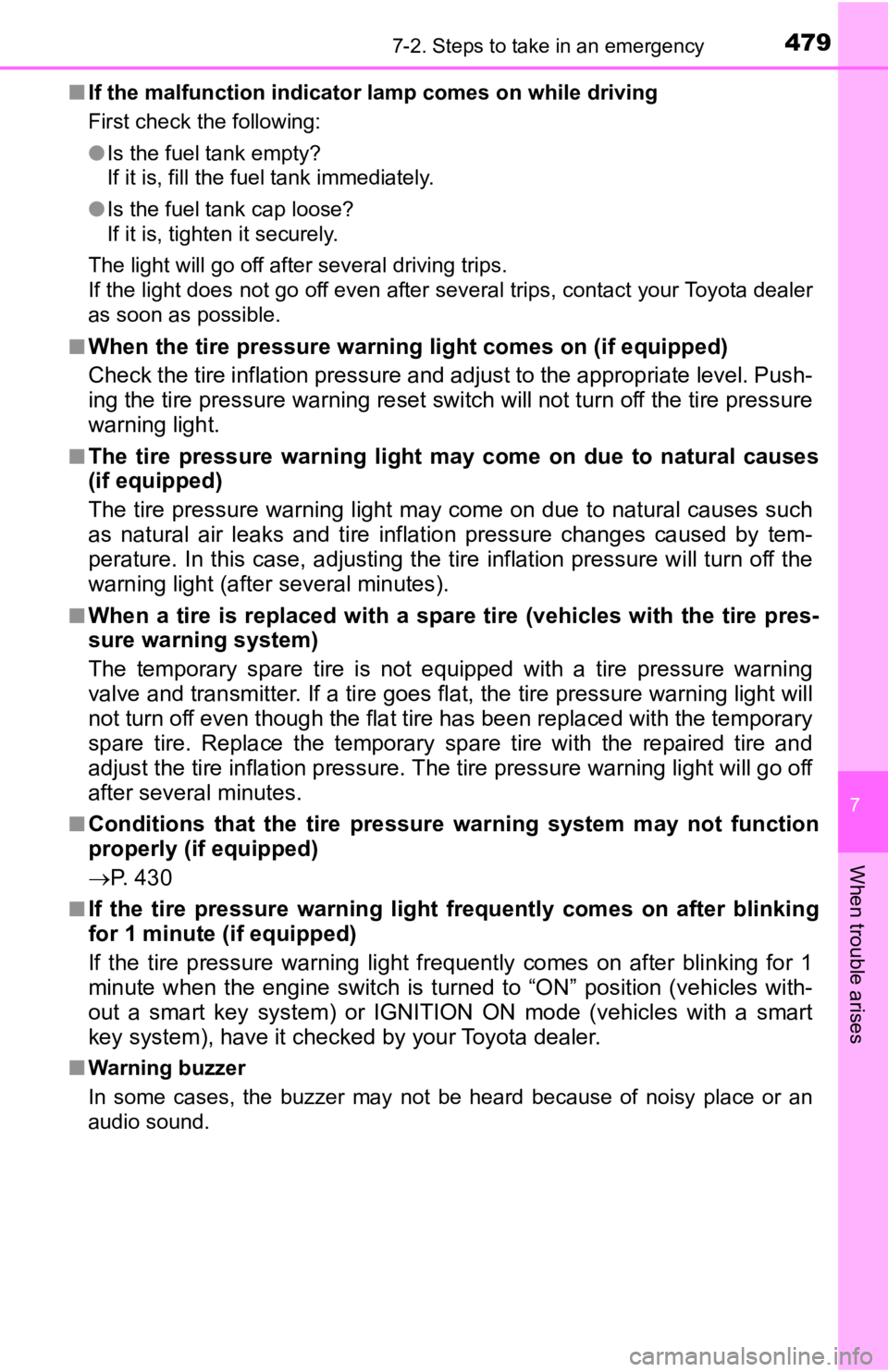
4797-2. Steps to take in an emergency
7
When trouble arises
■If the malfunction indicator lamp comes on while driving
First check the following:
●Is the fuel tank empty?
If it is, fill the fuel tank immediately.
● Is the fuel tank cap loose?
If it is, tighten it securely.
The light will go off after several driving trips.
If the light does not go off even after several trips, contact your Toyota dealer
as soon as possible.
■
When the tire pressure warning light comes on (if equipped)
Check the tire inflation pressure and adjust to the appropriate level. Push-
ing the tire pressur e warning reset switch will not turn off the tire pressure
warning light.
■The tire pressure warning light may come on due to natural caus es
(if equipped)
The tire pressure warning light may come on due to natural caus es such
as natural air leaks and tire inflation pressure changes caused by tem-
perature. In this case, adjusting the tire inflation pressure w ill turn off the
warning light (after several minutes).
■When a tire is replaced with a spare tire (vehicles with the ti re pres-
sure warning system)
The temporary spare tire is not equipped with a tire pressure w arning
valve and transmitter. If a tire goes flat, the tire pressure w arning light will
not turn off even though the flat tire has been replaced with t he temporary
spare tire. Replace the temporary spare tire with the repaired tire and
adjust the tire inflation pressu re. The tire pressure warning l ight will go off
after several minutes.
■Conditions that the tire pressure warning system may not functi on
properly (if equipped)
P. 4 3 0
■If the tire pressure warning light frequently comes on after bl inking
for 1 minute (if equipped)
If the tire pressure warning light frequently comes on after bl inking for 1
minute when the engine switch is turned to “ON” position (vehic les with-
out a smart key system) or IGNITION ON mode (vehicles with a sm art
key system), have it checked by your Toyota dealer.
■Warning buzzer
In some cases, the buzzer may not be heard because of noisy pla ce or an
audio sound.
Page 480 of 608

4807-2. Steps to take in an emergency
WARNING
■If both the ABS and the brake system warning lights remain on
Stop your vehicle in a safe place immediately and contact your Toyota
dealer. The vehicle will become extremely unstable during braki ng, and the
ABS system may fail, which could cause an accident resulting in death or
serious injury.
■ If the tire pressure warning light comes on (if equipped)
Be sure to observe the following precautions. Failure to do so could cause a
loss of vehicle control and result in death or serious injury.
● Stop your vehicle in a safe place as soon as possible. Adjust the tire infla-
tion pressure immediately.
● If the tire pressure warning light comes on even after tire inf lation pressure
adjustment, it is probable that you have a flat tire. Check the tires. If a tire
is flat, change it with the spare tire and have the flat tire repaired by the
nearest Toyota dealer.
● Avoid abrupt maneuvering and braking. If the vehicle tires dete riorate, you
could lose control of the steering wheel or the brakes.
■ If a blowout or sudden air leakage should occur (vehicles with the tire
pressure warning system)
The tire pressure warning system may not activate immediately.
■
Maintenance of the tires (vehicles with the tire pressure warning
system)
Each tire, including the spare (if provided), should be checked monthly
when cold and inflated to the inflation pressure recommended by the
vehicle manufacturer on the vehicle placard or tire inflation p ressure
label (tire and load information label). (If your vehicle has t ires of a dif-
ferent size than the size indicated on the vehicle placard or t ire inflation
pressure label [tire and load information label], you should de termine
the proper tire inflation p ressure for those tires.)
As an added safety feature, your vehicle has been equipped with a tire
pressure monitoring system (TPMS-tire pressure warning system) that
illuminates a low tire pressure telltale (tire pressure warning light)
when one or more of your tires is significantly under-inflated. Accord-
ingly, when the low tire pressure telltale (tire pressure warni ng light)
illuminates, you should stop and check your tires as soon as po ssible,
and inflate them to the proper pressure. Driving on a significa ntly
under-inflated tire causes the tire to overheat and can lead to tire fail-
ure. Under-inflation also reduces fuel efficiency and tire tread life, and
may affect the vehicle’s handling and stopping ability.
Page 486 of 608
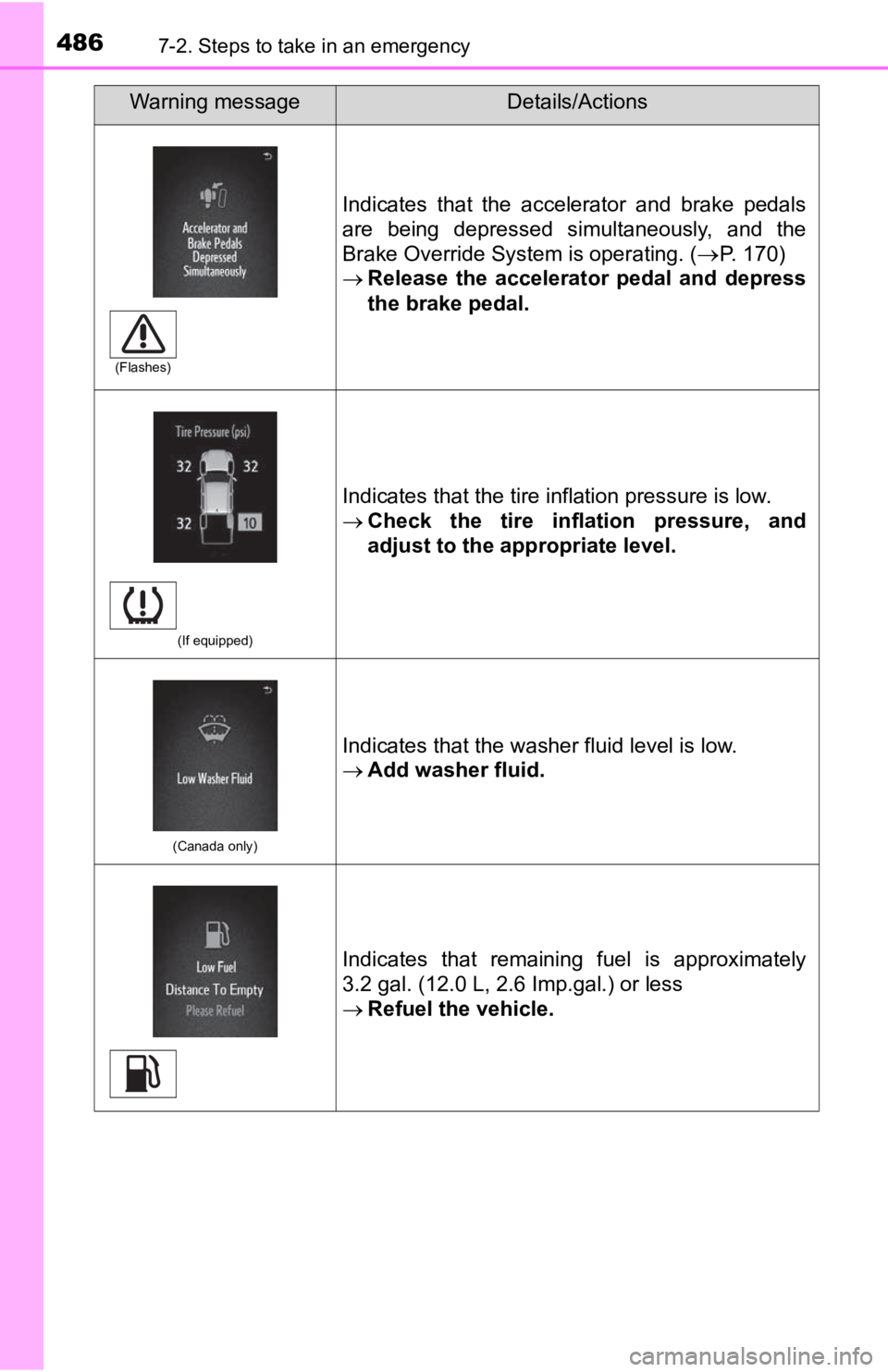
4867-2. Steps to take in an emergency
Indicates that the accelerator and brake pedals
are being depressed simultaneously, and the
Brake Override System is operating. (
P. 170)
Release the accelerator pedal and depress
the brake pedal.
(If equipped)
Indicates that the tire inflation pressure is low.
Check the tire inflation pressure, and
adjust to the appropriate level.
(Canada only)
Indicates that the washer fluid level is low.
Add washer fluid.
Indicates that remaining fuel is approximately
3.2 gal. (12.0 L, 2.6 Imp.gal.) or less
Refuel the vehicle.
Warning messageDetails/Actions
(Flashes)
Page 555 of 608
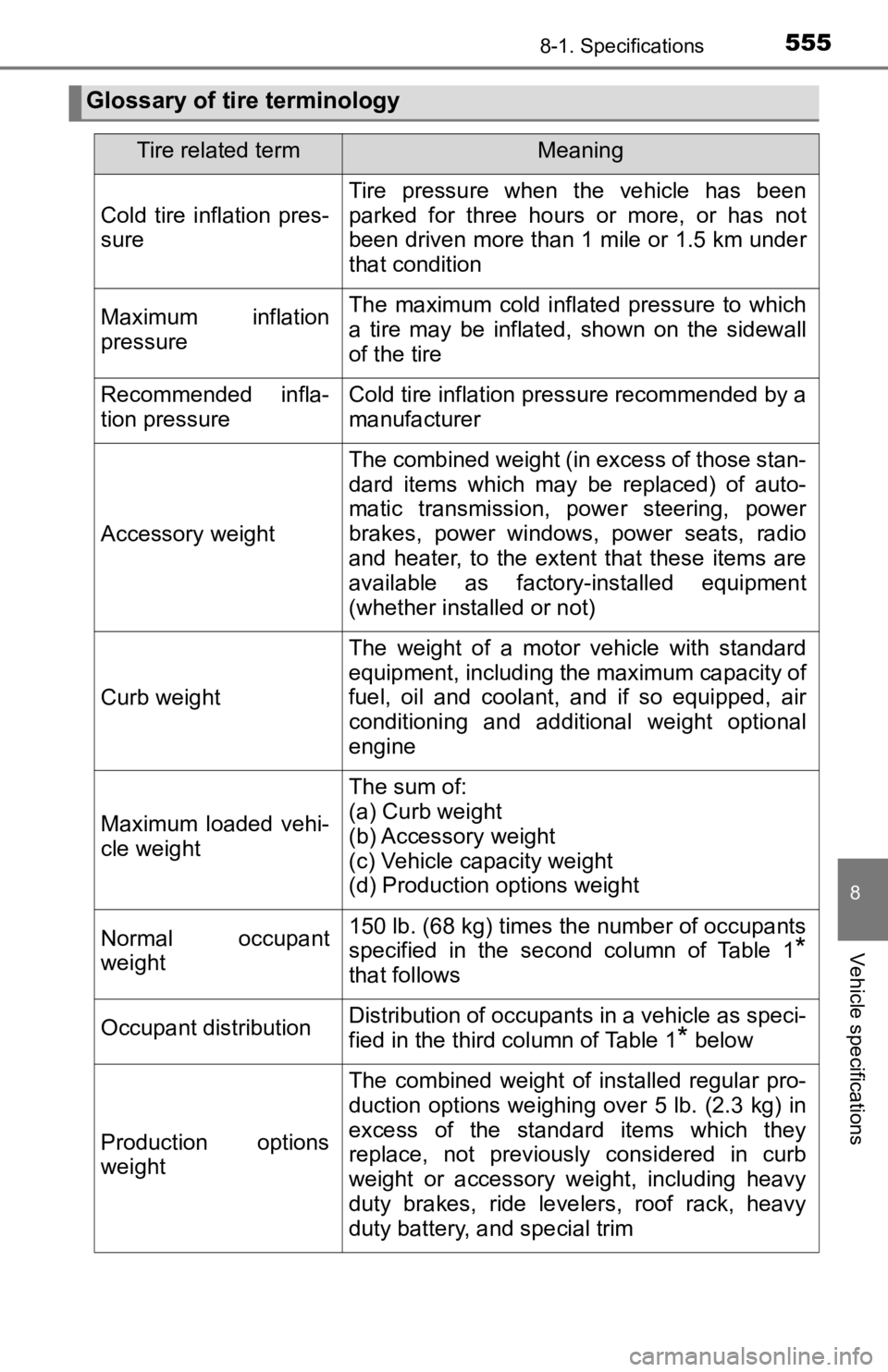
5558-1. Specifications
8
Vehicle specifications
Glossary of tire terminology
Tire related termMeaning
Cold tire inflation pres-
sure
Tire pressure when the vehicle has been
parked for three hours or more, or has not
been driven more than 1 mile or 1.5 km under
that condition
Maximum inflation
pressureThe maximum cold inflated pressure to which
a tire may be inflated, shown on the sidewall
of the tire
Recommended infla-
tion pressureCold tire inflation pressure recommended by a
manufacturer
Accessory weight
The combined weight (in excess of those stan-
dard items which may be replaced) of auto-
matic transmission, power steering, power
brakes, power windows, power seats, radio
and heater, to the extent that these items are
available as factory-installed equipment
(whether installed or not)
Curb weight
The weight of a motor vehicle with standard
equipment, including the maximum capacity of
fuel, oil and coolant, and if so equipped, air
conditioning and additional weight optional
engine
Maximum loaded vehi-
cle weight
The sum of:
(a) Curb weight
(b) Accessory weight
(c) Vehicle capacity weight
(d) Production options weight
Normal occupant
weight150 lb. (68 kg) times the number of occupants
specified in the second column of Table 1
*
that follows
Occupant distributionDistribution of occupants in a vehicle as speci-
fied in the third column of Table 1
* below
Production options
weight
The combined weight of installed regular pro-
duction options weighing over 5 lb. (2.3 kg) in
excess of the standard items which they
replace, not previously considered in curb
weight or accessory weight, including heavy
duty brakes, ride levelers, roof rack, heavy
duty battery, and special trim
Page 607 of 608
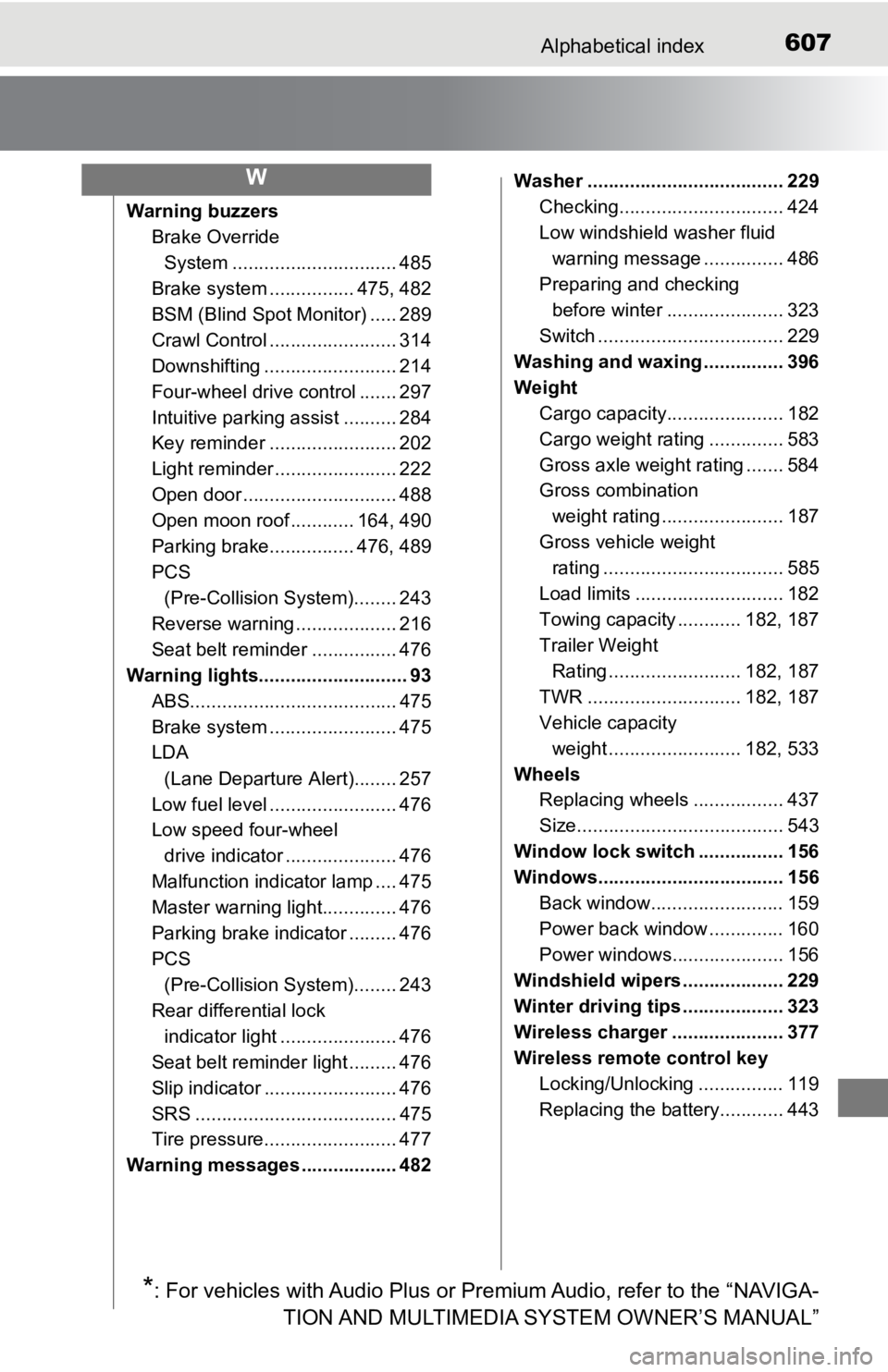
607Alphabetical index
Warning buzzersBrake Override System ............................... 485
Brake system ....... ......... 475, 482
BSM (Blind Spot Monitor) ..... 289
Crawl Control ........................ 314
Downshifting ......................... 214
Four-wheel drive control ....... 297
Intuitive parking assist .......... 284
Key reminder ........................ 202
Light reminder ....................... 222
Open door ............................. 488
Open moon roof ............ 164, 490
Parking brake................ 476, 489
PCS (Pre-Collision System)........ 243
Reverse warning ................... 216
Seat belt reminder ................ 476
Warning lights............................ 93
ABS....................................... 475
Brake system ....... ................. 475
LDA
(Lane Departure Alert)........ 257
Low fuel level ........................ 476
Low speed four-wheel drive indicator ..................... 476
Malfunction indicator lamp .... 475
Master warning light.............. 476
Parking brake indicator ......... 476
PCS (Pre-Collision System)........ 243
Rear differential lock indicator light ...................... 476
Seat belt reminder light ......... 476
Slip indicator ......................... 476
SRS ...................................... 475
Tire pressure......................... 477
Warning messages .................. 482 Washer ..................................... 229
Checking............................... 424
Low windshield washer fluid warning message ............... 486
Preparing and checking before winter ...................... 323
Switch ................................... 229
Washing and waxing ............... 396
Weight Cargo capacity...................... 182
Cargo weight rating .............. 583
Gross axle weight rating ....... 584
Gross combination
weight rating ....................... 187
Gross vehicle weight rating .................................. 585
Load limits ............................ 182
Towing capacity ............ 182, 187
Trailer Weight Rating ......................... 182, 187
TWR ............................. 182, 187
Vehicle capacity weight ......................... 182, 533
Wheels Replacing wheels ................. 437
Size....................................... 543
Window lock switch ................ 156
Windows................................... 156 Back window......................... 159
Power back window .............. 160
Power windows..................... 156
Windshield wipers ................... 229
Winter driving tips ................... 323
Wireless charger ..................... 377
Wireless remote control key Locking/Unlocking ................ 119
Replacing the battery............ 443
W
*: For vehicles with Audio Plus or Premium Audio, refer to the “ NAVIGA-
TION AND MULTIMEDIA SYSTEM OWNER’S MANUAL”